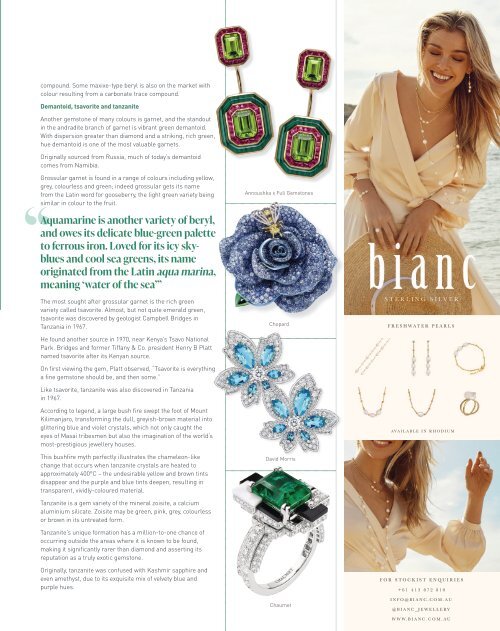Jeweller - September 2021
Create successful ePaper yourself
Turn your PDF publications into a flip-book with our unique Google optimized e-Paper software.
compound. Some maxixe-type beryl is also on the market with<br />
colour resulting from a carbonate trace compound.<br />
Demantoid, tsavorite and tanzanite<br />
Another gemstone of many colours is garnet, and the standout<br />
in the andradite branch of garnet is vibrant green demantoid.<br />
With dispersion greater than diamond and a striking, rich green,<br />
hue demantoid is one of the most valuable garnets.<br />
Originally sourced from Russia, much of today’s demantoid<br />
comes from Namibia.<br />
Grossular garnet is found in a range of colours including yellow,<br />
grey, colourless and green; indeed grossular gets its name<br />
from the Latin word for gooseberry, the light green variety being<br />
similar in colour to the fruit.<br />
Annoushka x Fuli Gemstones<br />
Aquamarine is another variety of beryl,<br />
and owes its delicate blue-green palette<br />
to ferrous iron. Loved for its icy skyblues<br />
and cool sea greens, its name<br />
originated from the Latin aqua marina,<br />
meaning ‘water of the sea’”<br />
The most sought after grossular garnet is the rich green<br />
variety called tsavorite. Almost, but not quite emerald green,<br />
tsavorite was discovered by geologist Campbell Bridges in<br />
Tanzania in 1967.<br />
He found another source in 1970, near Kenya’s Tsavo National<br />
Park. Bridges and former Tiffany & Co. president Henry B Platt<br />
named tsavorite after its Kenyan source.<br />
On first viewing the gem, Platt observed, “Tsavorite is everything<br />
a fine gemstone should be, and then some.”<br />
Like tsavorite, tanzanite was also discovered in Tanzania<br />
in 1967.<br />
According to legend, a large bush fire swept the foot of Mount<br />
Kilimanjaro, transforming the dull, greyish-brown material into<br />
glittering blue and violet crystals, which not only caught the<br />
eyes of Masai tribesmen but also the imagination of the world’s<br />
most-prestigious jewellery houses.<br />
This bushfire myth perfectly illustrates the chameleon-like<br />
change that occurs when tanzanite crystals are heated to<br />
approximately 400°C – the undesirable yellow and brown tints<br />
disappear and the purple and blue tints deepen, resulting in<br />
transparent, vividly-coloured material.<br />
Tanzanite is a gem variety of the mineral zoisite, a calcium<br />
aluminium silicate. Zoisite may be green, pink, grey, colourless<br />
or brown in its untreated form.<br />
Tanzanite’s unique formation has a million-to-one chance of<br />
occurring outside the areas where it is known to be found,<br />
making it significantly rarer than diamond and asserting its<br />
reputation as a truly exotic gemstone.<br />
Originally, tanzanite was confused with Kashmir sapphire and<br />
even amethyst, due to its exquisite mix of velvety blue and<br />
purple hues.<br />
Chopard<br />
David Morris<br />
Chaumet<br />
STERLING SILVER<br />
FRESHWATER PEARLS<br />
AVAILABLE IN RHODIUM<br />
FOR STOCKIST ENQUIRIES<br />
+61 413 872 810<br />
INFO@BIANC.COM.AU<br />
@BIANC_JEWELLERY<br />
WWW.BIANC.COM.AU


















